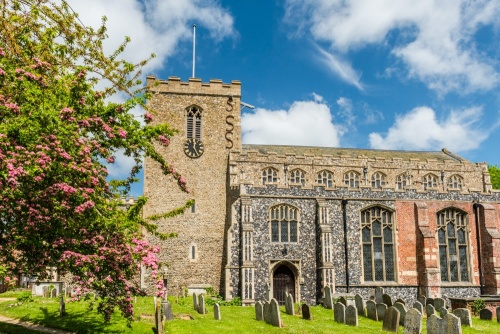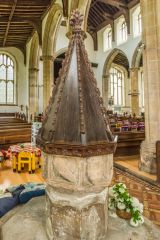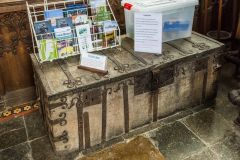
The Domesday Book of 1086 records two churches in the Suffolk village of Debenham. One, St Andrew's, was lost forever in the 13th century when, according to local legend, the earth opened up and swallowed the church whole, taking with it the entire congregation. The other, dedicated to St Mary, still stands and acts as the parish church.
History
The origins of St Mary's church are a matter of debate, but the herringbone stonework and the distinctive long and short quoins at the base of the tower probably date to the very late Saxon or very early Norman period, that is, sometime around AD 1075. Two round-headed windows in the south tower wall are probably early Norman.

The Galilee Porch
One very unusual feature is a huge 14th-century Galilee porch at the west end, giving access to the tower. Galilee porches are rare in Britain, and may have been used as places of penitence on Ash Wednesday, when people would do penance for their sins before being admitted into the church. They were also sometimes used for marriage ceremonies.
The Galilee porch is two-storeys high, with a priest's room above the passage. It is crowned with an embattled parapet decorated with gargoyles. The porch entrance has modern corbel heads on the exterior, but original medieval ones inside. The porch was restored in 1887 but it retains a medieval stall desk with traceried panels.

From the Galilee porch, you pass into the base of the tower, with ropes rising to bells above. 'Peal boards' on the wall record that in 1767 the ringers performed a 'plain Bob Major' that lasted a remarkable six hours and one minute, with 10,080 changes. That pales in comparison to what the local bell-ringers accomplished in 1892' a peal of Oxford Treble Bob Major that lasted 10 hours, 32 minutes and involved 16,608 changes.
A timber frame in the corner of the tower supports the bell frame above and dates to at least the 14th century.
The eastern arch of the tower certainly looks Saxon in style, though it may be early Norman.

Interior Highlights
The historical highlight of the nave is undoubtedly the superb early 15th-century hammerbeam roof. The roof spans 24 feet and rests on 15th-century angel corbels, though the angels that once decorated the ends of the hammerbeams are gone, perhaps removed by iconoclasts during the Reformation.
The aisle roofs are also medieval. The aisles themselves are separated from the nave by arcades of four bays. The arcade piers are late medieval, with beautifully carved capitals. They are thought to date to around 1420 and were possibly carved by a master mason from Occold named Hawes.
The nave and aisle floors are paved with locally-made bricks but the western end of the south aisle uses medieval paving stones of Purbeck marble.
Over the tower arch is a small sanctus bell window. This was likely used by a bell-ringer, giving him a clear view of the high altar so that he could ring a bell at the end of Mass. This sanctus bell would enable people who could not attend services (for example, because they were ill) to join in prayer at the correct moment.

The font base appears to be a reused font bowl, turned upside down, while the current bowl dates to around 1400. Another medieval treasure is the parish chest in the south aisle, dating to the late medieval period.
In the north chapel is a piscina made from fragments of medieval carving, including the 14th-century head of a bishop. The north chapel is thought to have been used by the local Guild of the Holy Trinity. Near the high altar is another 14th-century piscina beneath a richly decorated canopy.
The wooden pulpit dates to the 17th century and originally formed the upper section of a triple-decker pulpit.
The only old glass in the church is in the upper lights of the second window from the east in the north aisle.

Memorials
The oldest memorial is a brass in the chancel to John Framlingham of Crows Hall (d 1425) and his wife Margaret. The most impressive memorial, however, is the tomb of a later Framlingham, Sir Charles (d 1595) and his first wife Dorothy. The tomb was erected by Framlingham's second wife Elizabeth in 1598. The effigies of Sir Charles and Lady Dorothy are finely carved and show in beautifully detail what fashions were like the late Elizabethan period.
Another old memorial is a brass coffin plate commemorating Sir Charles Gawdy of Crows Hall (d 1650) with a long epitaph lauding his adherence to the Protestant faith and his support of Charles I in the Civil War. A hatchment to Sir Charles is on the south chancel wall near another hatchment to a later 17th-century Gawdy.
In the south aisle is the tomb of John Symson (d 1697), an apothecary whose bequest provided loaves of bread for the poor and coats for eight poor men and six poor women on Christmas Day.
In the south aisle floor is a medieval coffin lid with missing brass indents, and at the end of the aisle are four worn medieval grave slabs. In the nave floor is a ledger slab commemorating Nicholas Doole of Winston, whose epitaph describes him as 'That Famous Physician'.
Sy Mary's is a delightful historical building, full of interest, set in one of Suffolk's prettiest villages. It is in the centre of Debenham, on High Street. It was open when we visited.
About Debenham, St Mary's Church
Address: High Street,
Debenham,
Suffolk,
England, IP14 6QN
Attraction Type: Historic Church
Website: Debenham, St Mary's Church
Location
map
OS: TM174632
Photo Credit: David Ross and Britain Express
POPULAR POSTS
HERITAGE
 We've 'tagged' this attraction information to help you find related historic attractions and learn more about major time periods mentioned.
We've 'tagged' this attraction information to help you find related historic attractions and learn more about major time periods mentioned.
Find other attractions tagged with:
NEARBY HISTORIC ATTRACTIONS
Heritage Rated from 1- 5 (low to exceptional) on historic interest
Monk Soham, St Peter's Church - 2.7 miles (Historic Church) ![]()
Helmingham Hall Gardens - 3.5 miles (Garden) ![]()
Helmingham, St Mary's Church - 3.6 miles (Historic Church) ![]()
Stonham Parva, St Mary's Church - 4.2 miles (Historic Church) ![]()
Mendlesham, St Mary's Church - 4.6 miles (Historic Church) ![]()
Saxtead Green Post Mill - 4.6 miles (Historic Building) ![]()
Otley Hall - 4.7 miles (Historic House) ![]()
Earl Stonham, St Mary's Church - 5 miles (Historic Church) ![]()
Nearest Holiday Cottages to Debenham, St Mary's Church:
More self catering near Debenham, St Mary's Church












